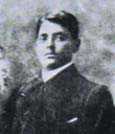They say success has many fathers and failure is like an orphan. This aphorism seems to be true of Jyotindranath Mukherjee, popularly known as Bagha Jatin, who attained martyrdom while fighting the British in an obscure Odisha village on September 10, 1915. Unfortunately, the supreme sacrifice made by Bagha Jatin and his comrades is little known outside Bengal and Odisha.
During the First World War, there was an attempt under Bagha Jatin's leadership to attain independence through armed insurrection in cooperation with Germany. The incident can be considered as a precursor to a later attempt by Subhas Chandra Bose during the Second World War in 1945.
Born in 1879 in Koya village in Kushtia district of undivided Bengal (presently Bangladesh), Bagha Jatin joined Khudiram Bose College in Calcutta in 1895. His dare devil spirit can be gauged from the fact that once in 1904, he killed with a dagger a tiger that had attacked one of his friends. The incident earned him the epithet of Bagha or tiger.
Bagha Jatin was greatly influenced by ideals of Bhagvadagita and the writings of Bankim Chandra. He was also inspired by Sri Aurobindo’s Bhavani Mandir and Swami Vivekananda’s Present India.
The clarion call of militant nationalism mesmerised the restless youth of the country, particularly after the Partition of Bengal in 1905. Disillusioned with the slow pace of the independence movement, they were losing faith in the efficacy of constitutional agitation involving protest and petition. The organisation that takes the credit for galvanising the spirit of strident nationalism was Jugantar and its icon was Bagha Jatin.
In 1905, he formed an association called Chhatra Bhandar. Although ostensibly it was a Student's Co-operative Store Association, it was practically an outfit of revolutionaries from Bengal. He mobilised a large group of youngsters. M.N. Roy of the Communist International fame came to know him in the later part of 1906 and accepted him as his leader. Both worked in tandem.
By early 1914, the country was agog with discontentment against the British rule. What added fuel to the fire was the promise of moral and material support to revolutionaries in India from revolutionaries fighting for the cause of independence from abroad. Indian revolutionaries-in-exile looked at Germany as the land of hope. Lala Hardyal of the Ghadar Party in America was also carrying out similar activities there. The legendary Rash Behari Bose went to Japan. By the end of the year, the news came that Indian revolutionary committee in Berlin, under the leadership of the Birendranath Chatterjee, had been promised arms and money required to declare the war of independence by the German government. Clandestine conferences led to the formation of a revolutionary outfit, with Bagha Jatin as commander-in-chief.
It was in this context that M.N. Roy left India in April 1915 and proceeded to Batavia (Djkarta) in Indonesia where he adopted the name C.A. Martin. Meanwhile, anticipating the arrival of the arms and ammunitions and in order to avoid being caught by the police, Bagha Jatin had left for Balasore in Orissa, along with a few followers. They too shelter in a place called Kaptipada, 22 miles from Balasore. Earlier that year, Saileswar Bose, an associate of Jatin Mukherjee, had set up a business at Balasore that ostensibly dealt with the repair of bicycles and the sale of gramophones and records.
Unfortunately, however, the entire strategy envisaged for the armed rebellion got leaked and the British army intelligence intercepted the ship that was on its way to India. After coming to know of the activities of Bagha Jatin and his associates, the British police cordoned off their hideout. An exchange of fire took place at Chasakhand on September 9. While one of the revolutionaries died in the attack, two were captured. Bagha Jatin was seriously wounded and taken to a government hospital where he succumbed to his injuries the next day.
Although the armed uprising could not take off, the brilliant strategy can't be ignored. No wonder then that rebel poet Kazi Nazrul Islam had described this event as the 'Haldighat of New India' where Maharana Pratap that had been militarily defeated, but ignited the flame of patriotism. He also composed a beautiful poem portraying the indomitable spirit of Bagha Jatin and his comrades.
However, much research needs to be done to unravel the mystery of the failure of the uprising and grant the martyrs their rightful place. It is worthwhile to recall what M.N. Roy wrote about Bagha Jatin in this context: “The time has changed; the man who earned fame as a great conspirator against the imperialist state and extraordinarily bold terrorist, is now to be memorialised as a great man in the history of modern India. His birthday is celebrated and biographies written. But since his time, the political stage of India has been crowded with people claiming niches in history, if not places of honour in the pantheon of the great. Judged by his actual feats, minus the legends woven around them, Jatinda's name may be crowded out of the list of the national heroes….”
Of the heroic fight at Balasore, Roy wrote, “There is no doubt that the story of Balasore jungle can be dramatised, and done by a master artist, it may attain the grandeur of an epic poem.…”
Great French philosopher Raymond Aron, who supervised the thesis of Prithwindra Mukherjee, grandson of Bagha Jatin, on Sri Aurobindo at the Sorbonne University, is said to have called Bagha Jatin as a ‘thinker in action’ and his story as the missing link in our official history.
The writer is a Director in the Research and Information Division of the Lok Sabha Secretariat
Unlock Exclusive Insights with The Tribune Premium
Take your experience further with Premium access.
Thought-provoking Opinions, Expert Analysis, In-depth Insights and other Member Only Benefits
Already a Member? Sign In Now










